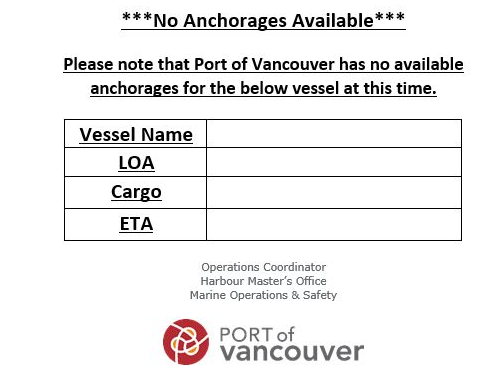Anchorage Availability
 The Port congestion that started in the opening weeks of 2020 has carried over into February. The Port of Vancouver Harbour Master provided the following advisory – “This is a general email to industry and stakeholders that the region is experiencing EXTREME congestion and high demand for anchorages. At the time of this email, there are 0 spots in English Bay/ Vancouver Harbour and 3 remaining in the Southern Gulf. The operations desk will do our best to encourage port fluidity and keeping with the regulations stated in the Port Information Guide.” It is expected that during the busy season local anchorages will experience congestion, however, a total non-availability of anchorages has never happened.
The Port congestion that started in the opening weeks of 2020 has carried over into February. The Port of Vancouver Harbour Master provided the following advisory – “This is a general email to industry and stakeholders that the region is experiencing EXTREME congestion and high demand for anchorages. At the time of this email, there are 0 spots in English Bay/ Vancouver Harbour and 3 remaining in the Southern Gulf. The operations desk will do our best to encourage port fluidity and keeping with the regulations stated in the Port Information Guide.” It is expected that during the busy season local anchorages will experience congestion, however, a total non-availability of anchorages has never happened.
There have been several instances this past month in which the Harbour Master has been unable to provide an anchorage under their jurisdiction. In 2 individual scenarios, vessels had completed partial loads and required anchorages between berthings. These situations are difficult as stability requirements prevent a vessel from departing local waters for sea (i.e. if in the rare case no anchorages available the vessel would not be able to depart between berthings). There are alternative anchorages managed by various authorities (including Nanaimo, Victoria and Port Alberni) that can be used if available, however, these positions have been near capacity as well. Fortunately, alternative arrangements were made in these cases and no delays occurred.
Alternative solutions were proposed including leaving the vessel at the berth until an anchorage was available. This is not a feasible solution long term as berth availability is rare and berthage would be incurred for the extra time spent alongside. For the majority of February, both local (English Bay & Inner Harbour) and remote (Southern Gulf Island) anchorages have been at or near capacity. The Port’s goal in these times is to maintain some fluidity. To do this, the Inner Harbour has been ‘reserved’ for vessels that need to bunker, await tidal windows, and conduct pre-loading inspections.
Unfortunately the situation is not limited to Vancouver as the Prince Rupert Port Authority provided a similar statement – “Agents… as rail disruption to the port continues, the anchorages administered by PRPA are nearing capacity … please be advised that until there is indication of rail movement and terminals are able to resume full activity, PRPA is unable to guarantee an anchorage for any vessel intending to call on Prince Rupert to load grain, coal or pellets … Further, as anchorage capacity is regained, we will prioritize anchorages to those vessels able to load product soonest.” In the last 2 weeks since that statement was received from the PRPA there has been some movement within the Port. As of today, there are approximately 5 of 27 anchorage spots available




 In addition to the wet weather that has plagued the start of this year, 2020 has already had its fair share of rail disruptions. Issues began in early February with a mudslide that washed out part of a rail track in the interior of BC. While there were no injuries, service was disrupted until crews were able to repair the affected area on 5 February.
In addition to the wet weather that has plagued the start of this year, 2020 has already had its fair share of rail disruptions. Issues began in early February with a mudslide that washed out part of a rail track in the interior of BC. While there were no injuries, service was disrupted until crews were able to repair the affected area on 5 February.